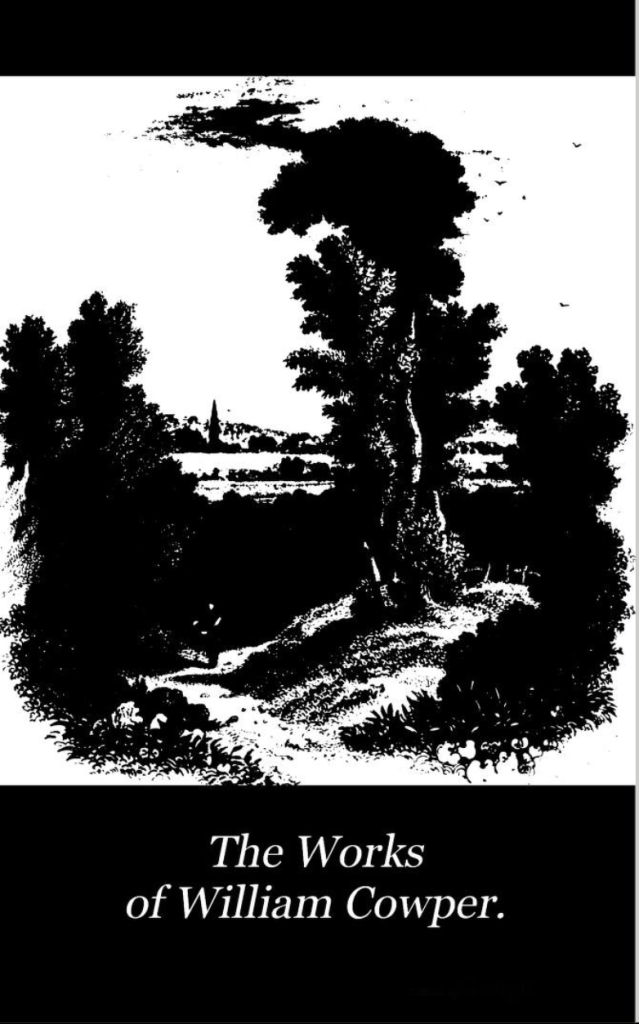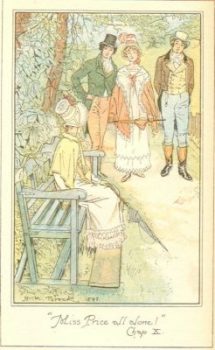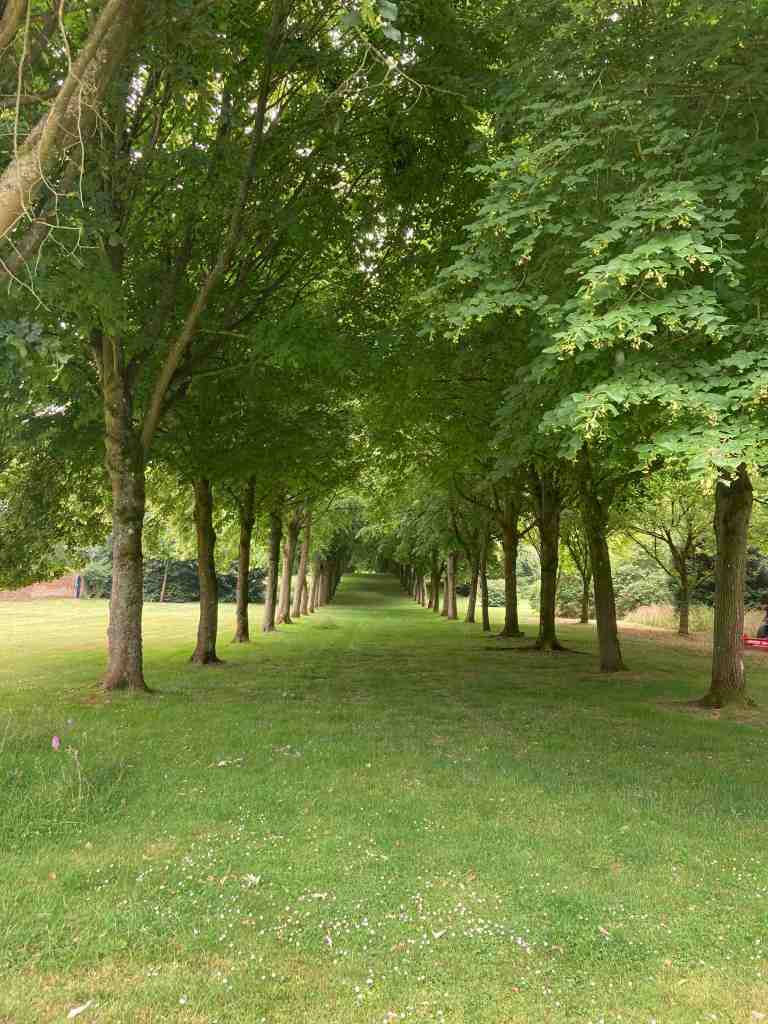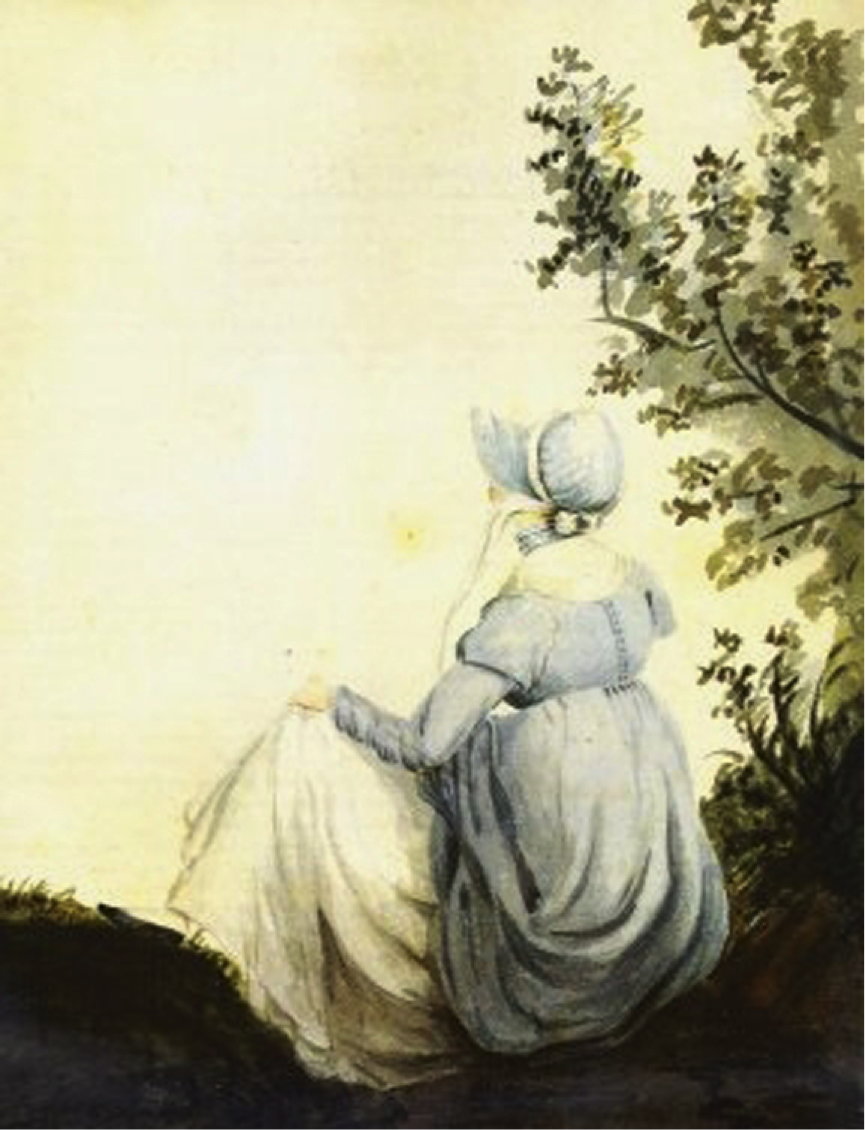By Brenda S. Cox
The sycamore, capricious in attire, Now green, now tawny, and ere autumn yet Have changed the woods, in scarlet honours bright.—William Cowper, The Task, Book I
The Seasons and Austen and Cowper
I lived in the desert for many years. Sometimes it was warmer, sometimes it was cooler, sometimes there was rain, mostly there was sunshine. Now that I’m living in Georgia once again, I love the seasons.
I delight in the changing array of flowers throughout the year. The trees are bare, then lovely shades of green, and now they are changing to red and yellow and brown. Dead leaves drift outside my window like falling rain. Each season has its particular beauties.
None knew this better than Jane Austen’s beloved poet, William Cowper. He lived most of his life in small country villages, taking long walks every day, and crafting his observations into poetry. He wrote, “God made the country, man made the town.”
Jane Austen’s nephew says Jane loved Cowper in both poetry and prose. The prose was his letters, published as early as 1803, three years after Cowper’s death and 14 years before Austen’s death. These letters have been called “some of the finest letters written in the English language.”

I recently read a selection of Cowper’s letters and a 1951 biography of Cowper by Norman Nicholson. I wrote earlier about Cowper’s long struggle with depression. This time, as I read Cowper’s letters, I was struck by how much Cowper loved nature, and how closely his love of nature was connected to his faith.
Jane Austen also loved nature. Jane enjoyed her gardens, which she embellished with a syringa (mock orange), “for the sake of Cowper’s line” (Feb. 8, 1807). That section, from Book 6 of The Task, begins:
What prodigies can power divine perform More grand than it produces year by year, And all in sight of inattentive man? . . .
All we behold is miracle: but, seen So duly [without wonder], all is miracle in vain.
Where now the vital energy that moved, While summer was, the pure and subtle lymph Through the imperceptible meandering veins Of leaf and flower? It sleeps: and the icy touch Of unprolific winter has impressed A cold stagnation on the intestine tide.
But let the months go round, a few short months, And all shall be restored.
These naked shoots, Barren as lances, among which the wind Makes wintry music, sighing as it goes, Shall put their graceful foliage on again, And more aspiring and with ampler spread Shall boast new charms, and more than they have lost. Then, each in its peculiar honours clad, Shall publish even to the distant eye Its family and tribe.
Laburnum rich In streaming gold; syringa ivory pure; The scented and the scentless rose . . .
So Cowper shows us the beauties of nature, while pointing out the miracle of the seasons and the wonder of God’s creation. Austen’s heroines also notice the seasons. Elizabeth Bennet, visiting Rosings, observes that “The five weeks which she had now passed in Kent had made a great difference in the country, and every day was adding to the verdure of the early trees.”
Fanny Price, when she visits her family in Portsmouth, realizes how much she misses the countryside at Mansfield Park. “She had not known before how much the beginnings and progress of vegetation had delighted her. What animation, both of body and mind, she had derived from watching the advance of that season which cannot, in spite of its capriciousness, be unlovely, and seeing its increasing beauties from the earliest flowers in the warmest divisions of her aunt’s garden, to the opening of leaves of her uncle’s plantations, and the glory of his woods.”

The Sublimity of Nature
When Fanny looks at the night sky with Edmund, she rhapsodizes.
‘Here’s harmony!” said she; “here’s repose! Here’s what may leave all painting and all music behind, and what poetry only can attempt to describe! Here’s what may tranquilise every care, and lift the heart to rapture! When I look out on such a night as this, I feel as if there could be neither wickedness nor sorrow in the world; and there certainly would be less of both if the sublimity of Nature were more attended to, and people were carried more out of themselves by contemplating such a scene.’
Cowper thought much the same. In a letter to John Newton (his mentor, the writer of “Amazing Grace”) on May 3, 1780, Cowper wrote,
I draw [as written poetic images] mountains, valleys, woods, and streams, and ducks, and dab-chicks. . . . O! I could spend whole days and moonlight nights in feeding upon a lovely prospect [view]! My eyes drink the rivers as they flow. If every human being upon earth could think for one quarter of an hour as I have done for many years, there might perhaps be many miserable men among them, but not an unawakened one could be found from the arctic to the antarctic circle. . . . I delight in baubles, and know them to be so; for rested in, and viewed without a reference to their Author, what is the earth, — what are the planets, — what is the sun itself but a bauble? Better for a man never to have seen them, or to see them with the eyes of a brute, stupid and unconscious of what he beholds, than not to be able to say, ‘The Maker of all these wonders is my friend!’
Nature and Science
Cowper observed nature, described it, and felt closer to God through his love of nature. But he didn’t think much of scientists who analyzed it. He wrote in another letter:
How happy, in comparison with myself, does the sagacious investigator of nature seem, whose fancy is ever employed in the invention of hypotheses, and his reason in the support of them! While he is accounting for the origin of the winds, he has no leisure to attend to their influence upon himself; and while he considers what the sun is made of, forgets that he [the sun] has not shone for a month.”
It’s hard to truly experience nature when you are analyzing it and experimenting on it. Cowper says that one scientific theory gives way to the next [which is still true today]:
One generation blows bubbles, and the next breaks them. But in the mean time your philosopher is a happy man. He escapes a thousand inquietudes to which the indolent are subject, and finds his occupation, whether it be the pursuit of a butterfly, or a demonstration, the wholesomest exercise in the world. . . . His discoveries, though eventually perhaps they prove but dreams, are to him realities. The world gazes at him, as he does at new phenomena in the heavens, and perhaps understands him as little. . . . He wears his honours while he lives, and if another strips them off when he has been dead a century, it is no great matter; he can then make shift without them. (Sept. 29, 1783, to his friend William Unwin)
I love Cowper’s dry humor; it reminds me of Jane Austen’s!
Nature and “Improvements”
The current craze was to get rid of geometrically arranged gardens and parks, replacing them with more “natural” views. Fanny Price laments the planned destruction of Sotherton’s “avenue,” a path or road lined with trees. She quotes The Task, where Cowper wrote, “Ye fallen avenues! once more I mourn Your fate unmerited.” He expands on this thought in a letter of July 28, 1788. In his neighbour’s “lime walk,” the trees had been trimmed to arch over the walk. Cowper wrote, “no cathedral in the world can show one [a walk] of more magnificence or beauty.” He said it was worth visiting for “the refreshment of such a gloom both to the eyes and spirits. And these are the things which our modern improvers of parks and pleasure grounds have displaced without mercy, because, forsooth, they are rectilinear! It is a wonder they do not quarrel with the sunbeams for the same reason.”

Long Walks
Several of Austen’s heroines, especially Elizabeth Bennet, love long walks. Sitting at my computer much of the day, I can relate to Cowper when he writes, “Air and exercise are necessary to all men, but particularly so to the man whose mind labours; and to him who has been all his life accustomed to much of both, they are necessary in the extreme” (Oct. 19, 1787, to Samuel Rose). Reading this just made me get up and go for a walk, enjoying the autumn leaves!
Our own perspective defines how we see nature, though. When Cowper’s depression, always present, became too deep, he lamented to his cousin, “Why is scenery like this . . . which many years since I could not contemplate without rapture, now become, at the best, an insipid wilderness to me? . . . My state of mind is a medium through which the beauties of Paradise itself could not be communicated with any effect but a painful one” (Oct. 13, 1798 to Lady Hesketh).
Cowper and the Evangelicals
Norman Nicholson’s biography, William Cowper, explores how Cowper’s connection with the Evangelical Revival of his time affected his writing and his view of nature. He concludes that Cowper’s Evangelical experience was crucial to his writing, since it gave him a deep emotional experience and gave life significance and value. It also led Cowper to appreciate nature as a revelation of God, though never to worship it as God is worshiped. It taught him to love animals as God’s creatures. He learned to “love not only his neighbour but his neighbourhood” (164). I think Jane Austen had this love for nature, as God’s creation, as well.
What do you love most about the natural world? What in creation directs your thoughts to God?
Recommended Reading
Chapters 15 (“Faith and Science: The Sublimity of Nature”) and 27 (“William Cowper: Jane Austen’s Beloved Poet”) in Fashionable Goodness: Christianity in Jane Austen’s England.
Brief biography with photos of items connected to Cowper
Discussion of Cowper’s life and poetry
The Life and Posthumous Writings of William Cowper, 1803, Vol. 1, Vol. 2, Vol. 3. (This title entertains me; it should be posthumously published writings . . .)
William Cowper: The Centenary Letters, edited by Simon Malpas, Manchester: Carcanet, 2000
William Cowper by Norman Nicholson, London: John Lehmann, 1951
(The last two obtained from Jane Austen Books.)



‘Syringa’ is lilac.
LikeLike
Actually “syringa” has been used to refer to several different plants. According to Kim Wilson (who wrote a book on Austen’s gardens), in Jane Austen’s England, “syringa” referred to what we call mock orange.
LikeLike
I dip into Cowper now and again. I’m always struck by how nature helps his fragile emotions hold together.
LikeLike
Yes. Nature was a way that he could find joy, however briefly.
LikeLike